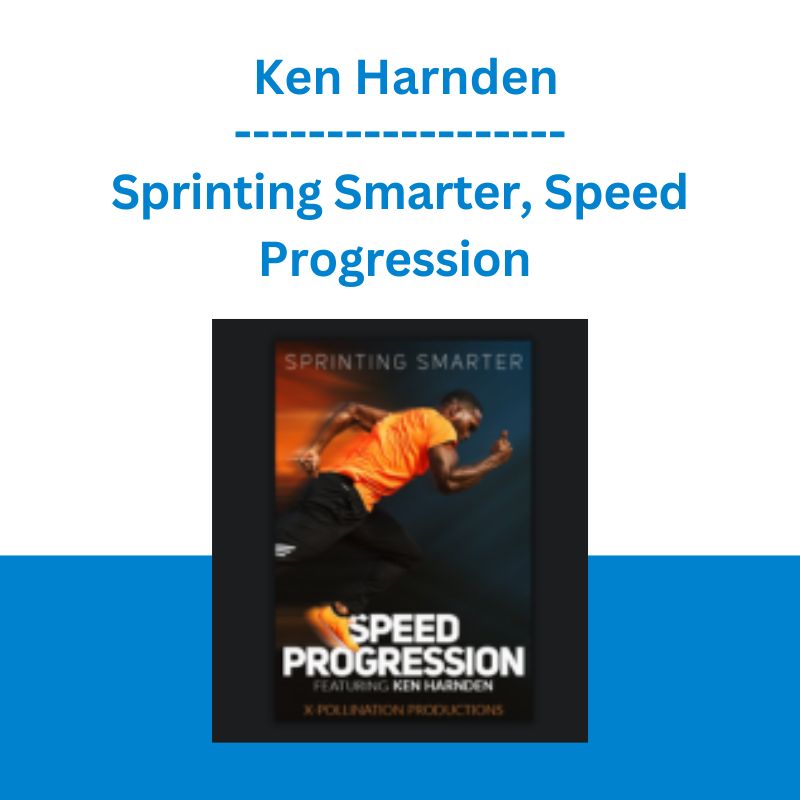*** Proof of Product ***
Exploring the Essential Features of “Sprinting Smarter, Speed Progression – Ken Harnden”
Sprint training and speed development built around an annual 5-phase progression designed to maximize speed and achieve peak performance at the right time.
What you’ll get
Included with the course
- 23 on-demand video lessons
- Training Guide
A detailed breakdown of the training progression with weekly sample workouts for each of the training phases.
What you’ll learn
TRAINING, DRILLS & LESSONS DESIGNED to maximize performance
- Sprinting Training Specific
Warm Up - Speed Development
- Acceleration Progression
- Block Start Technique
- Sprinting Mechanics
- Essential Elements of Speed
- Bounding Drills
- Building A Sprint Training Plan
- Plyometrics For Power
- Form & Stability Drills
- Box Jumps
- Max Velocity
- Recovery Phase
- And More
Course content
Lesson plan and chapter descriptions
Number of Lessons: 23
1. Course Introduction: Training for Speed
In order for a sprinter to maximize their potential, they must push themselves as close to the breaking point as possible. Whether that is training for explosiveness, power or endurance, an athlete must strive for top-end speed without getting injured. But sprint training is about much more than completing drills and honing technique. It takes specific training done with the right timing, intensity and focus to achieve top-end speed. Coach Harnden shares his overarching philosophies for fostering speed progression while reducing the risk of injury through a season.
2. Building a Sprint Training Plan
Planning is everything. Disorganized, random training will undoubtedly lead to random results. Ultimately great coaches and athletes know what they need to do to perform well and they deliberately work towards it. There are well-thought-out reasons behind every rep and each moment of recovery. It is that calculated planning and purposeful work that drives progress. In this chapter, Coach Harnden explains his process for creating his season training blueprint.
3. Acceleration Progression – 2 & 3 Point Starts
Sprinting is not just running fast. Ultimately, it’s about stride length, stride frequency and force production. So how do you learn to sprint and how should you progress through training? In this chapter, Coach Harnden shares the acceleration complex progression he uses, the technical focus of two-point and three-point starts and common errors.
4. Warm Up and Acceleration Progression
Prior to beginning any training, it’s critical to warm-up your muscles, joints and nervous system to handle the workout ahead. Additionally, attempting to do full sprints without proper progression will lead to injury. Learn Coach Harnden’s approach to the warm-up and speed-work progression through the phases of training.
5. Block Starts – Part I
The block start is the basis for how fast you’ll sprint. It sets-up the rest of the race and is the foundation of building speed through the race. Creating explosive power in the blocks is created through the proper postural angles and triple extension. This chapter outlines how to place the blocks and the form required to attain a solid sprint foundation.
6. Block Starts – Part II
Good sprinters are consistent and that consistency is vital with block starts. In a race, the athlete doesn’t come out of the blocks in a fatigue state so block starts shouldn’t be practiced in a fatigue state. This is why Coach Harnden’s athletes typically only do 5-8 block starts in a training session. However, in order for these block starts to be consistently done well, proper technique is critical. This lesson covers the key technical elements necessary for quality block starts and how to train to achieve them.
7. Block Starts – Focus Points
In this chapter, Coach Harnden explains how to set-up the blocks correctly for each athlete and the focal points of block-start technique.
8. Sprinting Mechanics
An athlete may have been gifted with natural speed, but without working on proper sprint mechanics, they will never reach their full potential. Mastering proper technique is not just necessary to sprint fast but also reduces the risk of injury. In this chapter, Coach Harnden shares the vital technical components of sprinting such as low heal recovery, hip alignment, arm action, ground contact and the common mistakes associated with them.
9. Essential Elements of Speed
To be fast, you have to train at a high level of intensity. You have to lift weights. You have to have explosiveness out of the blocks. You have to be able to perform under pressure during a race. However, there is no single training plan that will work for every athlete. Learn how Coach Harnden builds his training plans to get the best from each athlete.
10. Phase 1: Training to Train
To begin sprint training, you must first build a level of fitness to handle sprint training. In this lesson, learn how Coach Harnden begins the season for new incoming freshmen all the way to seasoned pros.
11. Phase 2: Event Specific Training
After building general fitness in phase 1, you are now ready to train specifically for sprinting. In this chapter, you’ll learn how to structure training as you begin to work on speed.
12. Phase 3: Speed Cycle
Phase three is a speed cycle and specifically designed to make you faster. This lesson outlines the structure, intensity and volume of the training in phase 3.
13. Phase 4: Athlete Specific Training
All athletes have a life outside of sprinting (or they should have one)! Phase 4 is a maintenance phase built around real life. Learn how Coach Harnden structures training around final exams and holidays to maintain the progress made through the previous phases.
14. Phase 5: Pre-Competition/Competition
This is the phase where all the work done in the previous phases is tested and realized. In this chapter, you’ll learn how Coach Harnden plans training for peak performance at specific times.
15. Sprint Training Warm Up
This lesson demonstrates the exercises and focus points of the warm-up Coach Harnden’s athletes do before every workout.
16. Pre Acceleration Drills
Before you begin working on acceleration in a training session, it’s important to get the body primed for good technique and injury prevention. This lesson includes the pre-acceleration drills Coach Harnden’s athletes do to get ready for speed. It also covers some common errors that can lead to poor form when sprinting.
17. Hurdle Drills for Sprinters
Hip movement, flexibility and range of motion are all necessary for speed and injury prevention. This lesson demonstrates some critical hurdle drills that are done nearly every day by Coach Harnden’s athletes to train the hip girdle using the same motions done while sprinting.
18. Plyometrics for Power
Getting the most out of your body and being efficient will allow you to create acceleration through your sprint. This comes from triple extension, stride length and stride frequency. In this chapter, you’ll learn some great drills to work on attaining triple extension and building power/explosiveness and through plyometrics.
19. Pre-Track Work Glute Activation
Prior to starting your track workout, it’s important to warm-up and activate the glutes. These exercises are typically done in the weight/training room before heading to the track. In this lesson, you’ll learn three glute activation exercises that can also help gauge external rotation of the foot, which can indicate that the hips are not square and lead to hamstring injuries.
20. Drills to Develop Form & Stability
Building on the warm-up and pre-acceleration work from the previous lesson, Coach Harnden shares some of the most effective drills for training form, posture, hip alignment and stability. Additionally, ankle joint drills that are done during plyometric workouts to build strength and flexibility are demonstrated.
21. Box Jump Drills
In general, Coach Harnden has athletes do low-level plyometrics during one session (less than 12”) and after a recovery of at least 72 hours, they do higher-level plyometrics. These plyometrics work on the same angles and postures used when sprinting in the blocks and also promote strength and explosive power. In this chapter, these drills are demonstrated and proper progression and energy systems are explained.
22. Acceleration, Max Velocity & Deceleration
There are three “phases” of a single sprint that are commonly discussed in sprinting. These are the acceleration, max velocity and deceleration phase. In this lesson, Coach Harnden shares the small differences in each phase that make significant differences in a race.
23. Recovery Phase
In a sport with a 1% differentiation between normality and greatness, recovery is key. Recovery is crucial to the foundation of every training cycle and is purposefully built into every phase. This chapter outlines the focus, timing and structure of recovery work done throughout the entire season.
Bonus Content
Included with the course
Training guide
The Speed Progression training guide provides you with a convenient resource that compliments the lessons and essential information taught throughout the course. It’s a great tool to use at the track when you need a quick reference to things like the warm-up sequence, plyometrics, hurdle drills and more.
You’ll also get a detailed breakdown of the training phases and principles that make-up the foundation of the course. This includes detailed weekly sample workouts for each of the phases of training and provides valuable specifics such as what speed and sprinting drills to perform on which days as well as the number of sets and reps that are adjustable to skill level and ability.
Meet the instructor
Learn why this coach is so effective
Ken Harnden
As a two-time Olympian, NCAA champion and Commonwealth Games bronze medal winner, Ken’s knowledge is rooted in firsthand training, trial and competition.
Currently serving as the Sprints Coach at Auburn University, the three-time USTFCCCA National Assistant Coach of the Year has guided 14 Olympians, 25 NCAA champions, and more than 160 All-Americans.
Dive deeper
Learn more about this course
Sprinting Technique
From standing starts all the way down to the nuances of the drive phase.
Coach Harnden covers every essential element of great sprinting technique in a logical and easy to follow progression. Starting with head, arm and torso positions and moving to foot strike and leg action. The acceleration progression guides athletes from rolling and static two-point starts and continues to build to three-point starts and eventually block starts. This sequencing ensures that the athlete is able to hit key positions prior to moving on to more complex movements. It also makes up the foundation that precedes many of the workouts in the training phases.
When it comes to learning sprinting technique, you simply have to see it in action. You’ll see every technical element in clear detail with easy to follow graphics and demonstrations from Olympians Warren Fraser and Cejhae Greene.
Sprinting Drills
Sprinting drills that deliver results.
Every drill included in this course serves a specific purpose and works hand-in-hand with the on-track instruction and training plan. This includes:
- Sprinting drills that target key technical aspects of sprinting – including foot strike, leg movement, hip position and core stability.
- Pre-acceleration drills that prepare the muscles and nervous system for speed development work.
- Plyometrics that develop power and explosiveness while reinforcing proper sprinting technique.
- Glute activation drills to maximize muscle recruitment and reduce the chance of injuries.
- Sprinting specific hurdle drills that improve mobility and range of motion.
- And more…
Training Plan Development
Deep insight into developing practice routines and an overall speed development training plan that can be customized for each individual athlete.
Planning is everything. Disorganized, random training will undoubtedly lead to random results. Over his 18 years of training elite athletes, Coach Harnden has learned that identifying a finishing point and working backward to plan the phases of training is the best way to ensure a successful season. This course will walk you through the phases Coach Harnden uses to create his season training blueprint step-by-step. Including:
- Phase One – Training to Train
- Phase Two – Begin Sprint Specific Training
- Phase Three – Speed Training
- Phase Four – Athlete Specific Training
- Phase Five – Pre Competition/Competition Training
- Phase Six – Recovery Phase
Please see the full list of alternative group-buy courses available here: https://lunacourse.com/shop/










 Julie Stoian & Cathy Olson - Launch Gorgeous - Funnel Gorgeous Bundle
Julie Stoian & Cathy Olson - Launch Gorgeous - Funnel Gorgeous Bundle